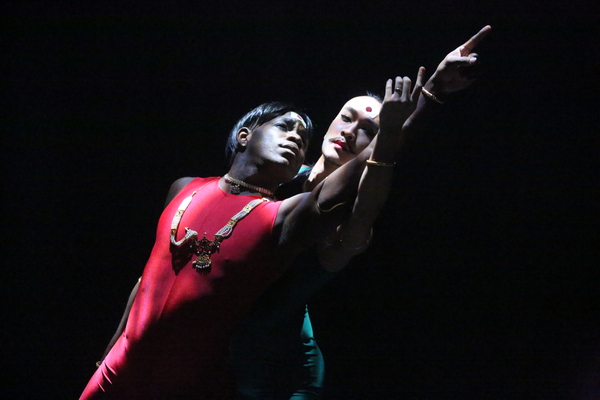Voir plus de photos ci-dessous - Cliquez ici
APERÇU
| Rôle | Type de voix | Gamme ? | Description du personnage |
|---|---|---|---|
| Prince | moyen-aigu | A Prince | |
| Newborn Woman | moyen-grave | A Woman born of the Prince's side | |
| Lover | moyen-aigu | Newborn Woman's new lover | |
| Danseur | muet-parlé | Represents inner feelings of Prince | |
| Danseur | muet-parlé | Represents inner feelings of New Woman |
SYNOPSIS
Unwilling to marry a woman, a man fashions a lover from his own left side. He’s enraptured by her perfect beauty – a mirror of his own – until he discovers that this new woman longs for freedom and wildly desires another.
Description musicale
Renseignements sur la première
| Rôle | Nom |
|---|---|
| Prince | Scott Belluz |
| Newborn Woman | Subhiksha Rangarajan |
| Lover | Alex Samaras |
| Danseur | Ravyn Wngz |
| Danseur | Sze-Yang Ade-Lam |
| Rôle | Nom |
|---|---|
| Chorégraphie | Hari Krishnan |
| Mise en scène | Marie-Nathalie Lacoursière |
| Direction musicale | Larry Beckwith |
| Set & Costume Design | Rex |
| Éclairage | Gabriel Cropley |
CRÉATION
Déclaration de l'équipe artistique
Just when you think you’ve grasped it, the story slithers away like a snake — that’s what keeps me fascinated. What seems like a familiar “woman born of man” creation story gets a feminist twist: the Newborn Woman outfoxes the Prince and heads off into a blissful future of new lovers. The tale comes from Karnataka in South India, where elements of matriarchal culture still play out in family structures. It’s not a myth, but a folk tale handed down from one generation of women to the next. It could be understood perhaps as a story of consolation for women enduring the hardships of life in a man’s world.
On a more personal note, the tale suggests the need to find a balance between what we might understand as the masculine and the feminine within each of us — to seek a more nuanced understanding of gender. The Prince locks up and limits the Newborn Woman — the Other — keeping what is different at a suspicious distance. In contrast, the Lover and the Newborn Woman fall in love through a gentle process of listening and exchange. The Lover uses imagination to understand what the Newborn Woman is telling him. Unlike The Prince, who imposes an idealized femininity onto the Woman, the Lover listens, waits and understands. Openness to difference and generosity of imagination transform our encounters with “the Other”, both within our selves and in the wider world.
- Juliet Palmer, composer
MÉDIAS
Il n'y a pas encore de critiques. Soyez le premier à en écrire un.
REVOIR CET OPÉRA
Vous devez être connecté pour soumettre un avis.
Soumettre une suggestion
Veuillez noter : comme nous faisons de notre mieux pour garantir que toutes les données de cette page sont correctes, veuillez comprendre que ces pages ont été créées par des humains, nous sommes donc voués à commettre des erreurs. Faites-nous savoir si vous avez trouvé des erreurs, des fautes de frappe ou des fautes sur cette page. Si vous avez des suggestions sur l'ajout de balises à cette page, veuillez également utiliser ce lien de courrier électronique. Merci, votre aide et votre contribution sont appréciées.




